STEM camp designed to help students solve problems
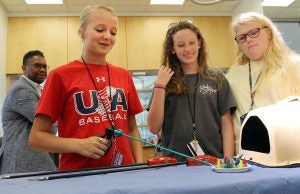
Karsyn Radford, left, an incoming freshman at Greene Central High School, operates a medical tool during a demonstration of the da Vinci robot during a College of Engineering and Technology STEM camp at ECU’s Heart Institute. (Photos by Ken Buday)
Three years ago, Meredith Warren saw a story about a person with dementia who had wandered away and gotten lost. Since then, the Greene County High School junior has been working to develop a device to help track lost dementia patients, and she’s gotten help along the way from ECU’s College of Engineering and Technology STEM camp.
“It’s a bracelet that has a tracking device that’s connected to an app called FamiSafe,” said Warren, who is attending the camp for the third time. “It’s a really loud alarm and it pings your location, and it shows the caretaker where that patient is. I have an actual working product that I have to make modifications to for size and accessibility.”
Warren’s effort is just one of six projects the group of 13 students is tackling during the four-day camp that started on Monday. Other projects involve decreasing the amount of plastic in oceans, reducing the amount of erosion affecting farmland, developing tennis equipment for those who have had arms amputated, helping sickle cell patients manage their symptoms and creating better barriers and doors to make schools safer.
“They are eager and excited, and have some good ideas,” said Dr. Ricky Castles, associate professor with the Department of Engineering, who is running the camp. “The big thing we’re working on is going from a big idea to a practical solution. Teenagers all want to save the world, but we have to get them to focus on what aspects can they really get behind and reasonably do in an academic year — what can they do to really make a difference — so honing in on something specific enough so it’s not so wide open that there is nothing tangible to produce.”
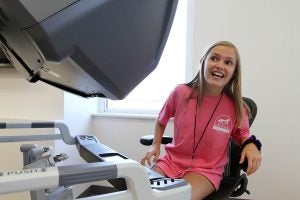
Katelynn Walters, an incoming freshman at Greene Central High School, sits down at the da Vinci robot during a College of Engineering and Technology STEM camp.
Castles said the camp helps show the students how science, technology, engineering and math play a role in helping create solutions to the problems they hope to solve.
“To do any of the projects, they have to understand the science of things,” Castles said. “Engineering is really nothing more than applying math and science to solve the problems of society, and all of their projects have some sort of societal implication to where knowledge of math and science can make a difference.”
As part of the camp, the students researched their projects in Joyner Library, saw a simulation lab and experienced what robotic surgery might be like with a demonstration of the da Vinci Si Surgical System at the Heart Institute at East Carolina University’s West Campus.
Student Cameron Miller took a turn trying to place a ring in a box using the da Vinci robot, which allows a surgeon to operate instruments remotely rather than directly with hands inside the patient, thus allowing for smaller incisions and faster recovery times.
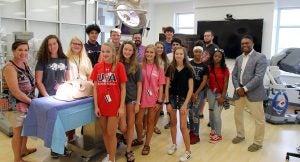
Students from Greene Central High School stand with instructors for a picture after a demonstration of the da Vinci robot.
“I loved it. It’s really cool,” Miller said.
Student Katelynn Walters said she had not seen robotic surgery before but enjoyed testing her skills.
“It was a lot of fun and definitely different than what you see on TV when they are doing hands-on surgery,” Walters said.
Student Karsyn Radford said she is interested in the medical field, looking at possible careers in forensics, pathology or surgery.
“It was nerve-racking a little bit, but overall, it was definitely cool,” Radford said of her chance to operate the da Vinci.
Student Chris Rivera looked beyond the operation of the robot.
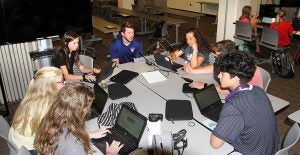
Students receive instructions on their projects during STEM camp.
“I’m interested in the engineering part, so I’m looking forward to seeing how to build one of these things,” Rivera said of the $2 million da Vinci. “It is really well built, so I’m looking at it from the engineering point of view, what I need to learn to work on something like this in the future.”
Overall, the students enjoyed the camp experience.
“I thought it was neat to look at different pathways, to learn and explore,” Radford said.
Funding for the camp came through the Greene County school system from the Burroughs Wellcome Fund.
– By Ken Buday, University Communications
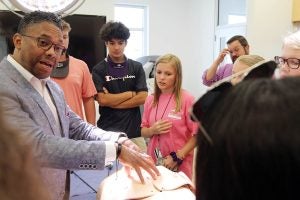
Jerome Fuller, left, director of telecommunications, networks and special projects at the Heart Institute at East Carolina University, gives a brief description about anatomy.

Students watch a screen during a da Vinci robot demonstration during the College of Engineering and Technology STEM camp at the Heart Institute at East Carolina University.